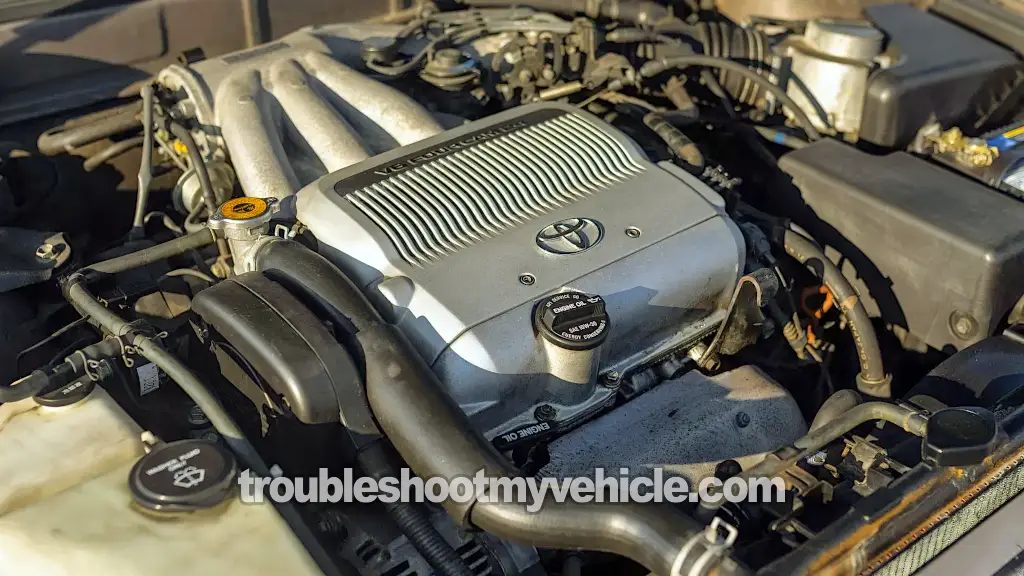
Figuring out why your Camry's engine won't start isn't hard, as long as you've got the right diagnostic strategy.
In this tutorial, I'm gonna walk you through my step-by-step method for diagnosing the most common causes of an engine no-start issue.
I'll also point you to the tutorials that'll help you test the specific parts you need to check. This way, you can figure out exactly what's keeping your Camry's engine from starting —without throwing parts at it.
Contents of this tutorial:
APPLIES TO: This tutorial applies to the following vehicles:
- 3.0L V6 Toyota Camry: 1992, 1993.
Difference Between A No-Start And A No-Crank Condition
Before you delve deeper into this tutorial, it's important that you know the difference between an engine no-start and engine no-crank problem.
Understanding the difference between these two types of problems is gonna help you diagnose the problem that much more effectively.
Here's the breakdown:
- No-Start: The engine cranks but does not start. This typically points to issues with the ignition or fuel system.
- No-Crank: The engine does not turn over, usually due to a dead battery or faulty starter motor.
If your Camry is suffering an engine no-crank problem, start by checking the battery and especially the starter motor.
Engine No-Start Diagnostic Basics
The most important thing to know, when troubleshooting an engine no-start problem on your Camry, is that the engine needs three things to start:
- Air (compression).
- Fuel.
- Spark
It's when one of these is missing from the mix, that your Camry's engine is gonna only crank, but not start.
With that in mind, the no-start condition in your 1992-1993 3.0L V6 Toyota Camry is usually caused by one of these major culprits:
Ignition system issues:
- Malfunctioning ignition components: This includes a bad ignition coil, a faulty igniter (ignition control module), worn-out spark plug wires, or issues with the distributor components (like the cap, rotor, or pickup coil).
- If any of the aforementioned ignition system components fail, the engine is not gonna start due to a lack of spark.
Fuel system issues:
- Faulty fuel pump: When the fuel pump fails, the engine doesn't receive any fuel, which leads to an engine that cranks but does not start.
Mechanical engine components:
- Blown head gasket: This can cause a loss of compression, overheating, and other symptoms that lead to engine no-start issues.
- Broken timing belt: A snapped timing belt means the camshaft and crankshaft can't stay in sync, which prevents the valves and pistons from working together. The end result is an engine that's not gonna start.
- Lack of engine compression: This is often due to worn piston rings, valve problems, or internal engine damage like a thrown rod. Without proper compression, the engine can't draw air into its cylinders, and it won't be able to compress the air-fuel mixture for ignition. If more than two cylinders are compromised, the engine isn't gonna start.
How Can I Troubleshoot A No-Start Problem?
Figuring out the exact cause of an engine no-start issue is a pretty straightforward process of elimination.
The goal is to start by confirming that all six cylinders are getting spark. From there, you methodically work through the most common component issues or failures, either confirming they're the problem or ruling them out before moving on to the next test.
This is the engine no-start diagnostic method I use:
- Check the ignition system first:
- This first diagnostic test involves checking that all six cylinders are getting spark.
- To get an accurate spark test result, it's very important to use a spark tester to check that all six spark plug wires are sparking (when cranking the engine).
- The following tutorials will walk you thru the ignition system testing process:
- If all six cylinders are getting spark, the ignition system is not causing the engine no-start problem. The next diagnostic step is making sure the engine is getting fuel.
- Check fuel pump pressure:
- The second step, after confirming all six cylinders are getting spark, is to make sure the fuel pump (located in the fuel tank) is OK and sending fuel to the fuel injectors.
- The fuel pump pressure is verified with a fuel pressure gauge.
- You can also confirm a lack of fuel (causing the engine to not start) with starting fluid.
- This tutorial explains the fuel pressure test and the starting fluid test step-by-step:
- If the ignition system is delivering spark to all six cylinders and the fuel pump pressure is within specification, the next step is to check the engine mechanical condition.
- Check for a blown head gasket:
- This is the first of the "engine mechanical condition" tests I recommend after confirming the engine has spark and fuel.
- Checking for a blown head gasket involves 4 tests. Two of them don't require any tools to do and can be done under 5 minutes.
- If the engine overheated (either recently or in the past) and now it doesn't start, a blown head gasket test is important to perform.
- The following tutorial explains the 4 blown head gasket tests you can perform:
- Test engine compression:
- This test involves using a compression gauge to check if each cylinder is doing its job.
- It's a straightforward way to see if the cylinders can build the pressure the engine needs to run.
- If a compression issue is causing your engine to not start, you'll likely find that:
- Most —if not all— six cylinders are producing low compression (under 100 PSI) or zero compression.
- This low or zero compression means the affected cylinder(s) can't generate the necessary pressure to ignite the air-fuel mixture, essentially rendering them "dead".
- This tutorial explains how to do and interpret a compression test:
- Inspect the timing belt:
- The timing belt needs to be replaced at specific mileage intervals (usually every 60,000 to 80,000 miles). If it isn't replaced during the specified interval, it'll eventually break, and when that happens, the engine won't start.
- There's quite a few methods to check if the timing belt is broken, this tutorial will help you with checking for a broken timing belt:
The most important thing to remember is that diagnosing an engine no-start issue is all a process of elimination. You start by checking the basics and work your way through the tests to see what's missing or not working properly.
By testing each of the components I've listed above, one at a time, you can systematically rule out what's working and focus on what's not.
If one part passes the test, you move on to the next until you find the culprit. It's a logical, step-by-step approach that's gonna save you time, money, and avoid unnecessary repairs.
What Tools Do I Need To Test An Engine No-Start
The right tool makes all the difference when diagnosing an engine no-start issue. Without the proper equipment, you're basically guessing —and that can lead to wasted time, money, and a ton of frustration.
Each of the following tool plays a specific role in pinpointing the root cause of the no-start issue, whether it's electrical, fuel-related, compression-related, or mechanical.
- Multimeter:
- Used to make sure components are getting power and Ground, and test electrical components like the distributor pickup coil, ignition coil, and wiring.
- If you don't have a multimeter, check this one out (it's the one I use): Tekpower TP8268 AC/DC Auto/Manual Range Digital Multimeter with NCV Feature (at: amazon.com).
- Spark Tester:
- A spark tester is the "go-to" tool to accurately test the ignition system for spark.
- This is the spark tester I use and recommend: OTC 6589 Electronic Ignition Spark Tester (at: amazon.com).
- Fuel Pressure Test Gauge:
- Measures the fuel pressure in the system to ensure the fuel pump and regulator are working correctly.
- Compression Test Gauge:
- Checks the compression levels in each cylinder to ensure the engine can build the necessary pressure for combustion.
- This is the tool I use and recommend: Actron CP7827 Compression Tester Kit (at: amazon.com).
- Chemical Combustion Leak Detector:
- Detects combustion leaks in the cooling system caused by a blown head gasket.
- Basic Hand Tools:
- Essential for removing components like spark plugs, fuel lines, or the distributor cap during diagnostics.
- Includes wrenches, sockets, screwdrivers, and pliers to access and inspect various parts of the engine.
More 3.0L V6 Toyota Camry Tutorials
You can find a complete list of 3.0L V6 Toyota Camry tutorials and wiring diagrams in this index:
Here's a sample of the tutorials you'll find there:
- How To Test Engine Compression (1992-2006 3.0L V6 Toyota Camry).
- How To Test For A Blown Head Gasket (1992-2006 3.0L V6 Toyota Camry).
- How To Test The TPS (1992-1996 3.0L V6 Toyota Camry).
- How To Test The MAF Sensor (1992-1993 3.0L V6 Toyota Camry).

If this info saved the day, buy me a beer!

